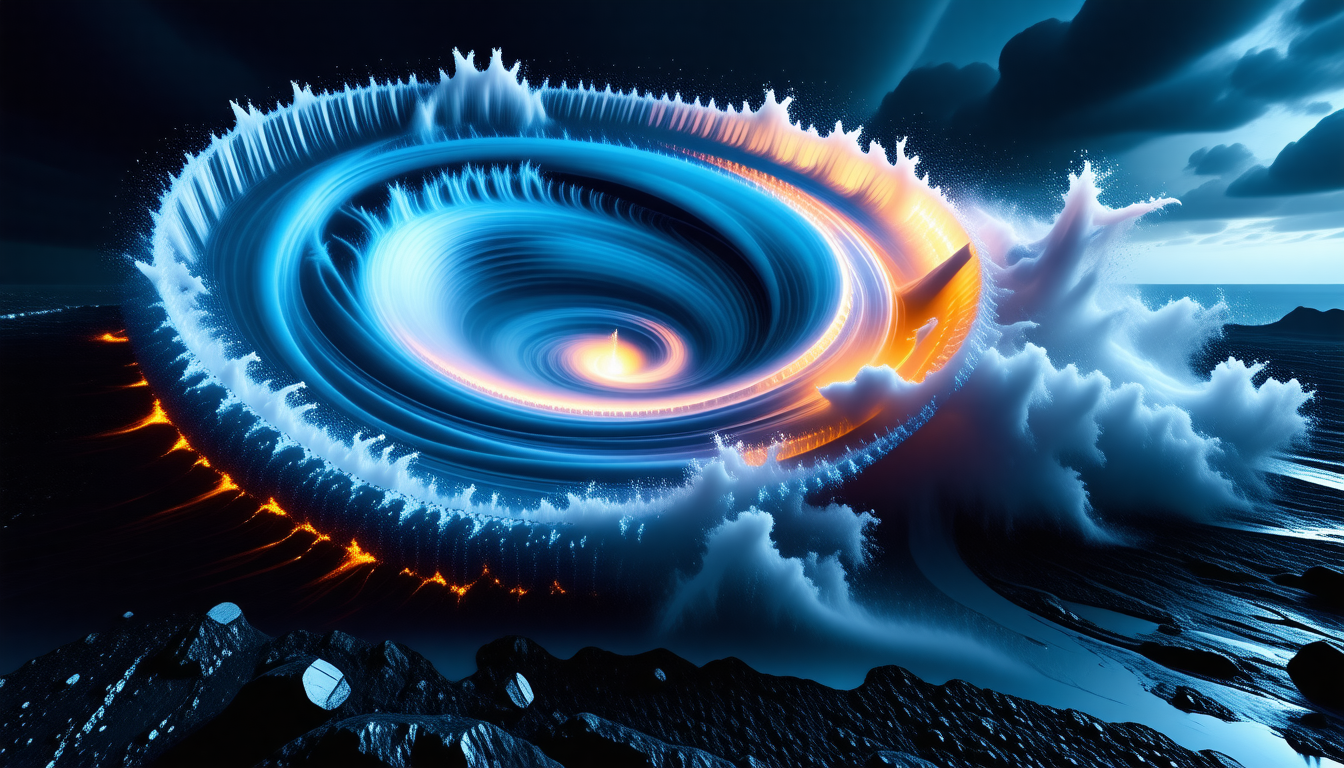Terrifying Worlds: Exploring the Cosmos’ Most Hostile Environments

Horrifying planetary environments and their characteristics
Beyond our Earthly sanctuary lies a startling realm of planets that redefine what we understand about habitability and the very essence of what constitutes an environment capable of sustaining life. The cosmos boasts a staggering variety of planetary environments, many of which are marked by extreme conditions that strain the limits of our imagination. These hostile worlds can be classified based on the intense features they exhibit—intense temperatures, hazardous atmospheric compositions, and devastating weather systems all contribute to their terrifying nature.
Take, for example, Venus, our nearest planetary neighbor, which serves as a cautionary tale in our quest for extraterrestrial exploration. Beneath its perpetually dense, acidic clouds lies a searing landscape where temperatures can exceed 400° C (750° F). This scorching climate is exacerbated by a crushing atmospheric pressure this is 90 times greater than that of Earth—a pressure that could obliterate any conventional spacecraft attempting to explore its surface. The thick clouds of sulfuric acid that envelop Venus not only contribute to its famous greenhouse effect but also obscure any glimmers of potential life. The lethal conditions on Venus starkly remind us that proximity to the Sun does not always guarantee warmth and comfort.
Meanwhile, in the outer reaches of our solar system, gas giants like Jupiter present their own formidable challenges. The planet’s Great Red Spot, a massive storm larger than Earth itself, rotationally whirls with hurricane-force winds and is blanketed in lethal radiation. The colossal size of Jupiter means its atmosphere is constantly dynamic, filled with swirling clouds that manifest colors unseen in the familiar skies of Earth. Any aspiring space probes must navigate these treacherous conditions, where the lethal radiation and intense pressure act like a cosmic death sentence for unshielded technology.
Ponder also HD 189733b, an exoplanet located about 63 light years away from Earth. This fascinating yet terrifying gas giant is known for its unthinkable winds, which can reach speeds of 2,000 mph and are laden with glass-like particles. Imagine a world where rain consists not of water but of molten glass, driven sideways by relentless gusts, striking the landscape with the force of shards. Its vividly blue atmosphere—an optical illusion created by silicate particles—belies the true danger hidden within, as storms rage across its surface, reminding us that appearances can be profoundly deceiving in the cosmos.
The understanding and categorization of these horrifying environments extend beyond our own solar system. The quest for exoplanets often yields worlds that exist in disturbingly hostile conditions. For instance, exoplanets such as GJ 581c and WASP-121b exhibit heavy atmospheric extremes or crystalline particles that could render their surfaces barren and inhospitable. GJ 581c, termed a “Goldilocks planet,” rests in a habitable zone where temperatures may theoretically permit liquid water, yet its thick atmosphere rich in carbon dioxide presents a perilous greenhouse effect akin to Venus. On the other hand, WASP-121b—boasting temperatures hot enough to melt metals—features an atmosphere laden with heavy metal clouds, introducing a metallic rain that challenges any classical understanding of weather phenomena.
In unraveling these planetary environments, scientists are not just cataloging terrifying worlds; they are redefining the limits of life itself. Each terrifying aspect—be it extreme heat, suffocating atmospheres, or relentless storms—reshapes our understanding of what constitutes a habitable world. This exploration compels us to reconsider the fundamental characteristics of life, urging us to envision possibilities far beyond our terrestrial experience. As we gaze into the cosmic abyss, these horrific planetary environments beg us to question our own existence and the fragility of life in an infinite universe filled with extremes that we have yet to fully comprehend.

Extreme weather patterns and temperature fluctuations
As we peer deeper into the cosmos, the extreme weather patterns and temperature fluctuations of distant worlds present an exciting yet terrifying display of nature’s power. Take, for instance, the exoplanet HD 80606b, which orbits in a highly eccentric path around its host star. Its orbit varies dramatically, bringing it perilously close at times and pulling it away at others. This stark shift results in extreme temperature fluctuations, where the planet can experience scorching highs of over 1,700° C when nearest to its star, only to plummet to frigid lows as it retreats. These rapid changes create an atmosphere in constant turmoil, marked by violent storms and chaotic weather systems.
Similarly harrowing conditions can be found on WASP-121b, where one might witness rain composed of molten glass falling sideways due to winds that can exceed 7,000 km/h—nearly seven times the speed of sound on Earth. This world, classified as a hot Jupiter, is not only a testament to extreme atmospheric dynamics but also serves as a reminder of how fluid the definitions of habitability can be. As it orbits much closer to its star than Mercury does to our Sun, the consequences of this proximity manifest as punishing temperatures and electric storms that bear little resemblance to anything we experience on our home planet.
The fluctuating climates of such worlds compel scientists to rethink the nature of weather patterns and how life might respond to them—or fail to survive. Under conditions where the temperature can swing from lethal heat to chilling depths, any potential ecosystem would have to be incredibly resilient to endure. The simultaneous existence of scorching temperatures and the possibility of rapid cooling creates zones of turbulence, leading to atmospheric instability that could reshape the landscape in an instant. This raises a profound question: how does life, or the potential for life, adapt to such volatile environments?
Think the prospect of living on a tidally locked planet like GJ 581c, which presents a different yet equally daunting scenario. One side perpetually bathed in warmth, while the flip side remains ensconced in eternal darkness forms an extreme temperature gradient that could lead to fierce weather phenomena. Fluctuating winds driven by these stark contrasts can birth catastrophic storms, much like those seen in Earth’s weather, albeit vastly exaggerated. This once again prompts us to ponder the flexibility of life—does it adapt to beauty like perpetual sunsets, or does it find a way to thrive in the horrific, frozen wastes of perpetual night?
The diversity of these extreme conditions cannot be overstated. For instance, the influence of a gas giant’s strong gravitational pull can exacerbate the intensity of storms, while proximity to dim stars can also inhibit heat retention. Each weather pattern, from electrical tempests on WASP-121b to the relentless winds on HD 189733b, illustrates how complex interactions between a planet’s atmosphere, its orbit, and its star define its viability for habitation. With every new discovery, scientists are painting a broader picture of how planetary environments function and evolve, significant for understanding not just individual worlds, but the very foundation around which our interpretations of habitability are built.
This exploration challenges our previously ascribed notions of where and how life can thrive. Looking beyond the comforting blue of Earth’s skies and the gentle cadence of its weather, we are compelled to expand our definitions of what is possible. The existence of planets where violent winds and temperature extremes define the very essence of their atmosphere invites us into a realm of inquiry that feels equally exhilarating and horrifying. As we prepare for future exploration of these distant worlds, one can’t help but wonder—what adaptations have evolved in the face of such challenges, and will they reshape our understanding of life itself?

Geological phenomena and potential for life
The terrifying landscapes of distant exoplanets often hold geological phenomena that challenge our understanding of planetary formation and evolution. Within these extraordinary environments lie clues about the mechanics that govern not only the formation of worlds but also the resilience of potential life forms adapted to extreme conditions. For instance, the volcanic activity in a planet like Corot 7b highlights the role played by tidal heating due to its proximity to its host star. As gravitational forces stretch and pull on the planet, immense internal friction generates heat, leading to active geology. The violent eruptions observed on Corot 7b resemble some of the most ferocious volcanic processes seen on Earth, further emphasizing the idea that geological similarities can stretch across the cosmos.
This extreme geological activity often creates atmospheres laden with volcanic gases, which can significantly impact a planet’s climate. For instance, a world such as GJ 581c, with its thick atmosphere potentially rich in carbon dioxide, poses questions about what forms of life—if any—could endure under such oppressive heat. Although it falls within the habitable zone of its star, the environmental pressures might yield a greenhouse effect that rivals Venus, suggesting that surface conditions could be inhospitable while harboring traces of ancient life or complex organics below its rocky surface.
The geological processes of planets in dire environments extend beyond mere surface phenomena. In icy worlds like Europa or Enceladus, beneath their frozen façades lie vast oceans that may allow for chemical interactions capable of supporting life. The interplay of heat from tidal forces, coupled with subsurface conditions, creates a juxtaposition to the more tempestuously volcanic worlds we observe further within our solar system. On Ganymede or Titan, for instance, scientists speculate about the chemistry facilitated by liquid water reservoirs under the ice, forming an ambient environment for potential life processes similar yet distinctly different from Earth.
Moreover, in examining planets like 55 Cancri e, the implications of a diamond-rich world evoke profound questions about material science and planetary evolution. The potential presence of diamonds and other crystalline structures might influence geological processes, suggesting unique interactions between temperature, pressure, and composition unlike any phenomena witnessed on our planet. This offers an exciting narrative: could life, as bizarre as we sometimes consider it could be, adapt to metabolize in environments rich in such unique mineral assemblies?
The geological features of these distant worlds are intrinsically linked to their climates and atmospheric stability, thus establishing a complex relationship that nurtures or eradicates life. Their environments force us to reconsider not only the qualities needed for a planet to support life but also the range of adaptations organisms might develop in the face of seemingly insurmountable odds. Understanding how life could possibly exist under such extreme conditions invites us into a broader conversation on the flexibility and adaptability of life throughout the universe.
What makes this analysis even more compelling is the technological advancements that continue to enhance our exploration of these celestial environments. Telescopes and exploratory spacecraft equipped with sophisticated sensors and imaging techniques unlock previously unattainable insights into the chemical compositions of planetary atmospheres. As we refine our observational strategies and leverage computer modeling to simulate extreme conditions, the potential to discover new forms of life—possibly thriving on planets with geological features alien to us—becomes less like science fiction and more a tantalizing possibility on the frontier of astrobiological research.
Thus, as we endeavor to unravel the mysteries of these geological phenomena on distant worlds, we are not merely cataloging dangerous landscapes; we are engaging in a profound exploration of life’s potential. The exploration of these horrifying yet fascinating planetary environments compels us to expand and enrich our understanding, as we inch closer to comprehending the vast complexities of the universe and the myriad possibilities that lie within it.
Scientific exploration and technological advancements in exoplanet research
In the relentless pursuit of knowledge about exoplanets, scientists have harnessed an array of advanced technologies to probe the depths of our cosmic neighborhood. These innovations not only enrich our understanding of alien worlds but also enhance our ability to detect and characterize potentially habitable planets. Among the pivotal methods employed, the transit photometry technique stands out. This method involves measuring the subtle dimming of a star’s light when a planet passively crosses in front of it. By analyzing these alterations in brightness, astronomers can infer critical data about an exoplanet’s size, density, and even some atmospheric attributes. The ability to detect such faint signals from distant worlds allows scientists to build elaborate models of their characteristics.
Alongside transit photometry, direct imaging techniques have become increasingly sophisticated. Telescopes equipped with adaptive optics can effectively cancel out the overwhelming brightness of stars, revealing the faint glow emitted by orbiting planets. This method opens a window into the atmospheres of these celestial bodies, allowing scientists to detect the presence of specific gases that suggest the potential for life. For instance, identifying water vapor or carbon dioxide in an exoplanet’s atmosphere can be indicative of conditions conducive to biological processes.
In addition to these observational techniques, spectroscopic analysis has emerged as a vital tool in planetary research. By studying how light interacts with the molecules in a planet’s atmosphere, astronomers can gain insight into its chemical composition. This analysis can reveal clues about temperature variations, cloud formation, and the potential presence of biological signatures, thus offering a broader understanding of the conditions on these remote worlds.
Notably, missions like the James Webb Space Telescope are set to revolutionize our exploration of distant exoplanets. With its advanced infrared capabilities, it will allow astronomers to peer deeper into planetary atmospheres and unveil the underlying chemical makeup of distant worlds. The stunning sensitivity of such next-generation telescopes can lead to groundbreaking discoveries, including identifying habitable zones around distant stars or detecting the molecular signatures of life.
As our exploration techniques become more refined, the potential for discovering new exoplanets expands substantially. Automated observational missions equipped with sophisticated algorithms can sift through vast amounts of data, identifying planetary candidates amid the noise of cosmic background radiation. These automated systems act like digital hunters, continuously seeking out the faintest signals from potential worlds where life might thrive.
The international collaboration among researchers also fosters innovation, combining data from terrestrial observatories and space missions to refine our understanding of exoplanetary systems. By sharing findings and cross-analyzing data, scientists can build a more comprehensive picture of the myriad planetary systems in our galaxy.
This surge in technological capabilities resonates beyond mere exoplanet detection; it shapes our philosophical approach to life in the universe. The combination of modern tech and multidisciplinary research invites the possibility that life could exist in forms we are yet to imagine, adapting to environments that seem utterly inhospitable to us. As we continue to develop tools and techniques for exploring the cosmic abyss, we inch closer to yielding answers to age-old questions about our existence and the potential for life flourishing beyond the confines of Earth.
Each newfound exoplanet discovered acts as a beacon, illuminating the vast tapestry of the cosmos and inspiring future generations of scientists and dreamers alike to probe deeper into the mysteries of life among the stars. Ultimately, with every advancement in technology and every exoplanet cataloged, we not only expand our knowledge but also reaffirm the exhilarating notion that the universe is filled with unexplored territories and untapped mysteries waiting for us to uncover.